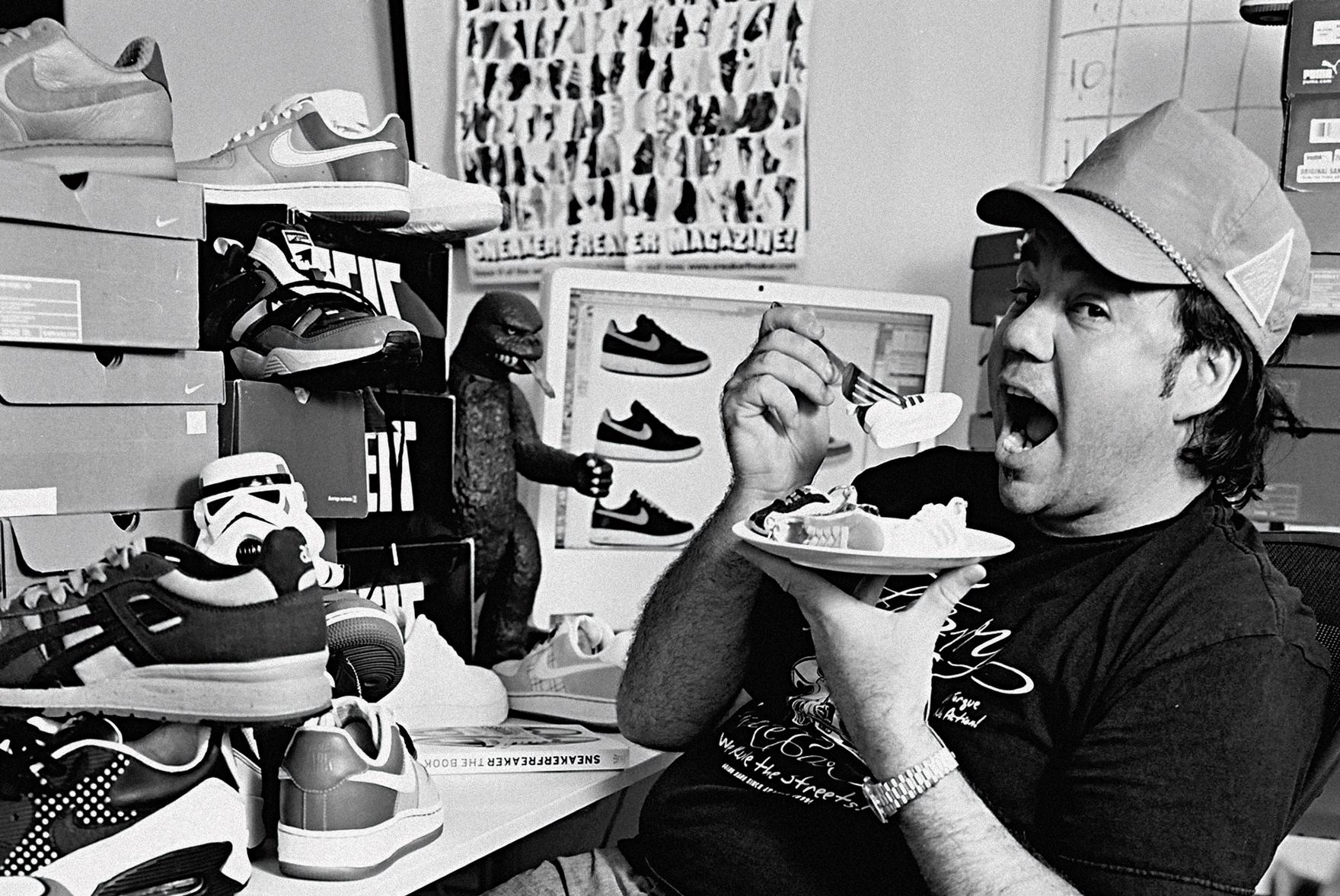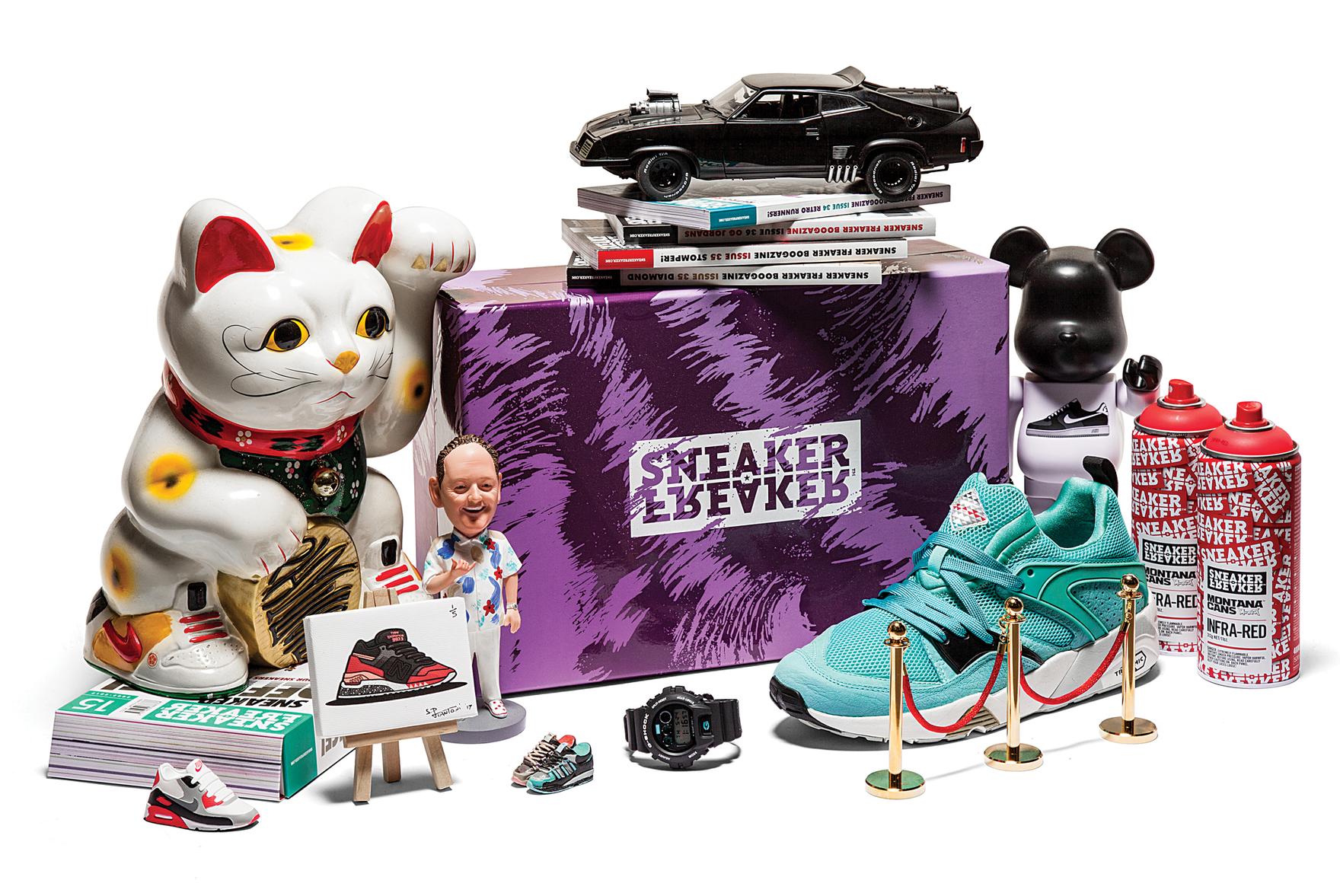The Definitive Guide to Sneaker Freaker!
It’s funny how life plays out. Imagine you’re daydreaming and an idea pops into your head. It could be the wackiest scheme in the world or total genius – who knows? Do you give up before you even get started or do you… just do it? Let’s say you opt for the latter. Then bam!, a decade and a half flies past and you’re wondering what the hell happened. Obsessions will do that to you.
Back in 2002, after working in advertising, film design and fashion, I was gripped by the urge to start a magazine. My motivation was pretty simple. I wanted Nike and adidas to send me free shoes. Loads of free shoes. Enough to fill a FedEx truck! And I wanted that truck to come back every month with more boxes to add to my stash.
One week later I was the proud owner of Sneaker Freaker, the world’s first magazine dedicated to the cult of sneakers. I had no grand plan – still don’t! – but that wasn’t important because I was now a publishing magnate. What I didn’t know was that my new gig would take over my life and send me around the world hundreds of times like some globetrotting sneaker gigolo.
My dream came true, that’s for sure. And I know what you’re thinking right now. How many? In all honesty, I don’t know the exact number, but let’s just say I have enough to get me through the next decade and a half without wearing the same pair twice. The thrill of a freebie never gets old, but I still buy plenty of sneakers simply because one can never have too many, though storage does become an issue when you hit four figures. Besides, it’s my job.

The 2000s
At the start of the millennium, the internet was a primitive frontier. Dial-up was standard, e-commerce was limited and social media was still a twinkle in Zuckerberg’s brown eyes. Basic blogs kinda existed, but digital photography was a pipedream. If you really wanted to shop for cool shoes, you had to jump on a plane to Tokyo, London or New York. The ‘good old days’ were pretty basic in hindsight, but I look back on that lack of sophistication with misty-eyed pride. Before Google indexed the world, you had to work hard to acquire knowledge. I spent hours diligently trying to decode the sneakers that featured on album covers and in grainy VHS music videos. That sense of mystery and wonderment was a seductive motivator and still is to this day.
Way before ‘sneakers’ were considered the ‘coolest’, let alone a vocation, my collection filled several closets and made me the butt of many hilariously original Imelda Marcos jokes. (It’s amazing how vivid the memories of that woman’s shoe collection are!) Some were still mint in their boxes while others were trashed beyond repair, but my daily rotation was deep enough that I could go several monthswithout wearing the same pair twice. This wasn’t considered something to brag about and on the odd occasion when the extent of my habit was revealed, shock rather than awe was the reaction.
It wouldn’t be right to say that I didn’t think of sneakers as status symbols or that I wasn’t aware of their cultural cachet, but the fact is I did not know a single person who was into sneakers the way I was. Every now and then I’d snap a neck (figuratively speaking) in a club or on the street that signified my Nikes had been noted, but that was the extent of the fraternity. I was in an underground secret society with a membership of one.
When the first issue of Sneaker Freaker dropped in 2002, my Motorola V70 rang off the hook. Radio stations, newspapersand magazines wanted to interview this sneaker-crazed nutjob who loved shoes so much he started a magazine. The Imelda Marcos jokes rolled thick and fast once again, much to my amusement. It was an exciting time.
More importantly, I discovered that I was not Robinson Crusoe. Hundreds of people turned up to the first magazine launch at Revolver in Melbourne. Enthusiasts came out of the closet to join the Sneaker Freaker online forum and engage in desktop gossip. Around the world, amateur sneakerheads with similar backgrounds to mine were also plotting professional transitions. Alife opened on New York’s Lower East Side. In Berlin, Hikmet Sugoer rolled out the first Solebox boutique, just as Sneakersnstuff, Undefeated, Footpatrol, Opium and atmos were fitting out their debut doors. Credit to Fixins, Crooked Tongues and the NikeTalk forum for pioneering the digital sneaker media space.
When Nike collaborated with the New York skate brand Supreme in late 2002 to create a pair of coveted ‘Elephant Print’ Dunks, the sense of a globally connected community was suddenly plausible. Like a contagious pop culture virus, the scene rapidly multiplied and mutated, adding otaku-level minutiae to the lexicon. Limited editions, collaborations, samples, Japan-only editions, Quickstrike, Hyperstrike, Tier Zero, knockoffs, deadstock, vintage, customs, one-of-ones, artist colabs, retailer tie-ins, player-protos and retro reissues – there was so much newness to absorb on the daily that it made heads spin and blogs roll. Soon enough, every brand had identified this new breed of ‘sneakerhead’ as a highly lucrative demographic.
By the time the second issue was on the press, stores like Colette (RIP) in Paris had placed orders and I was sucked into the international sneaker vortex. Jetting off to New York, Tokyo and London to attend launch events and talk turkey directly with brands was surreal. To my complete surprise, my thoughts and opinions about nostalgia and retro footwear were being taken seriously.
The Magazine
In the first editorial, I promised that Sneaker Freaker would be ‘funny and serious, meaningful and pointless all at the same time.’ Fifteen years later, I still think that might be the best expression of what I wanted the magazine to represent. For many hardcore aficionados, there is nothing remotely funny about their obsession, but I’ve always thought that taking the piss was the ultimate accolade. Hopefully there’s also enough honest grit in these pages to remind readers that we’re not victims of hyperbole, though we certainly love dishing it out with gusto!
Inspired by the DIY punk fanzine movement, the first few issues were closer to a homemade brew than a professional publication. The content was unpredictable and raw, and I look back with a certain comical detachment. Like Cher, I do wish I could turn back time and ditch that cornball graffiti font I used on the cover of the first few issues! Today the magazine is a well-oiled machine, and though there’s a lot to be said for keeping things real, staying locked in that groove doesn’t pay the bills for long.
Funnily enough, the first edition of Sneaker Freaker has become a serious collectible. Just 3000 copies were printed and nowadays they change hands for hundreds of dollars. After years of pilfering and shrinkage, there are just three copies left in the office library. The dozen boxes I had stashed under my desk for years afterwards but gave away in a mad decluttering mission? Priceless!
The first example of going deep on a story arrived in Issue 6 with Jason Le’s brilliant Steve Van Doren interview (page 597). Steve’s memories of the ups and downs at Vans were heartfelt, and I resolved to be more ambitious with the scope of the magazine’s anthropological storytelling. Unexpectedly, I was finding the business of how sneakers are made, marketed and sold to be endlessly fascinating. Being an industry insider was a revelation.
Another key milestone was ticked off in mid-2006. I was desperate to join the collaboration club but hadn’t the faintest idea how to apply. Thanks to Mark Godwin at Lacoste, we popped our cherry with the Missouri tennis trainer. Black suede, grey nubuck, white mesh and a sprinkle of mint pops is a classic combo that has thankfully stood the test of time. On a hot August night, the Alife Rivington Club’s courtyard was packed with a cabal of industry identities and LES hustlers. Just 24 pairs were given away, with another 200 pairs released globally a few weeks later. It was supremely satisfying to ‘make it’ in New York.
Since then, Sneaker Freaker has designed sneakers with everyone from adidas to ASICS and Diadora. Detours into accessories and knick knacks came with G-SHOCK, Montana Cans and Medicom. We’ve also written and designed books for Nike, New Balance, PONY, Casio, Reebok and Globe.
The fact that Sneaker Freaker is based in my hometown of Melbourne, Australia, is something that many readers likely never realised. Running a global business from Down Under is not the most logical idea, but if Sneaker Freaker has demonstrated anything, it’s that nothing is impossible if you just do it. (Sorry!) Our geographical isolation simply makes the magazine’s global success even weirder. At one point we opened offices in Germany, Spain and Russia and published several editions in those languages. When Kobe Bryant’s people inquired about acquiring the company several years ago, I couldn’t stop smiling for weeks.
Strange, isn’t it, that a few bits of leather and suede sewn onto a slab of rubber and wrapped in nylon thread could mean so very much to so many.
This article first appeared as the intro to , which was released in 2019 via TASCHEN. The next Sneaker Freaker book will be released late in 2020.
